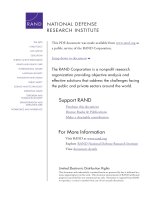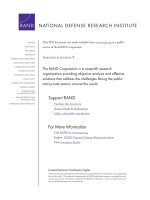Measuring the Statutory and Regulatory Constraints on DoD Acquisition - Research Design for an Empirical Study potx
Bạn đang xem bản rút gọn của tài liệu. Xem và tải ngay bản đầy đủ của tài liệu tại đây (2 MB, 131 trang )
This document and trademark(s) contained herein are protected by law as indicated in a notice appearing
later in this work. This electronic representation of RAND intellectual property is provided for non-
commercial use only. Permission is required from RAND to reproduce, or reuse in another form, any
of our research documents for commercial use.
Limited Electronic Distribution Rights
This PDF document was made available from www.rand.org as a public
service of the RAND Corporation.
6
Jump down to document
THE ARTS
CHILD POLICY
CIVIL JUSTICE
EDUCATION
ENERGY AND ENVIRONMENT
HEALTH AND HEALTH CARE
INTERNATIONAL AFFAIRS
NATIONAL SECURITY
POPULATION AND AGING
PUBLIC SAFETY
SCIENCE AND TECHNOLOGY
SUBSTANCE ABUSE
TERRORISM AND
HOMELAND SECURITY
TRANSPORTATION AND
INFRASTRUCTURE
WORKFORCE AND WORKPLACE
The RAND Corporation is a nonprofit research
organization providing objective analysis and effective
solutions that address the challenges facing the public
and private sectors around the world.
Visit RAND at www.rand.org
Explore RAND National Defense Research Institute
View document details
For More Information
Purchase this document
Browse Books & Publications
Make a charitable contribution
Support RAND
This product is part of the RAND Corporation technical report series. Reports may
include research findings on a specific topic that is limited in scope; present discus-
sions of the methodology employed in research; provide literature reviews, survey
instruments, modeling exercises, guidelines for practitioners and research profes-
sionals, and supporting documentation; or deliver preliminary findings. All RAND
reports undergo rigorous peer review to ensure that they meet high standards for re-
search quality and objectivity.
Measuring the Statutory
and Regulatory Constraints
on DoD Acquisition
Research Design for an
Empirical Study
Jeffrey A. Drezner, Raj Raman, Irv Blickstein,
John Ablard, Melissa A. Bradley, Brent Eastwood,
Maria Falvo, Dikla Gavrieli, Monica Hertzman,
Darryl Lenhardt, Megan McKernan
Prepared for the Office of the Secretary of Defense
Approved for public release; distribution unlimited
The RAND Corporation is a nonprofit research organization providing objective analysis
and effective solutions that address the challenges facing the public and private sectors
around the world. RAND’s publications do not necessarily reflect the opinions of its research
clients and sponsors.
R
®
is a registered trademark.
© Copyright 2006 RAND Corporation
All rights reserved. No part of this book may be reproduced in any form by any electronic or
mechanical means (including photocopying, recording, or information storage and retrieval)
without permission in writing from RAND.
Published 2006 by the RAND Corporation
1776 Main Street, P.O. Box 2138, Santa Monica, CA 90407-2138
1200 South Hayes Street, Arlington, VA 22202-5050
4570 Fifth Avenue, Suite 600, Pittsburgh, PA 15213
RAND URL: />To order RAND documents or to obtain additional information, contact
Distribution Services: Telephone: (310) 451-7002;
Fax: (310) 451-6915; Email:
The research described in this report was prepared for the Office of the Secretary of Defense
(OSD). The research was conducted in the RAND National Defense Research Institute, a
federally funded research and development center sponsored by the Office of the Secretary
of Defense, the Joint Staff, the Unified Combatant Commands, the Department of the
Navy, the Marine Corps, the defense agencies, and the defense Intelligence Community
under Contract DASW01-01-C-0004.
Library of Congress Cataloging-in-Publication Data
Measuring the statutory and regulatory constraints on DoD acquisition: research design for an empirical study /
Jeffrey A. Drezner [et al.].
p. cm.
Includes bibliographical references.
ISBN-13: 978-0-8330-3967-5 (pbk. : alk. paper)
1. United States. Dept. of Defense—Procurement—Costs—Study and teaching. 2. United States. Dept. of
Defense—Rules and practice—Study and teaching. I. Drezner, Jeffrey A.
UC263.M42 2006
355.6'2120973—dc22
2006022427
iii
Preface
Over the past two decades, the Department of Defense (DoD) has been striving to make
acquisition-related statutes and regulations less burdensome to program offices. While many
studies have focused on the “costs” of doing business with DoD, few have attempted to quan-
tify the actual cost of compliance.
e Office of the Under Secretary of Defense for Acquisition, Technology, and Logistics
(OUSD[AT&L]) asked the RAND Corporation’s National Defense Research Institute (NDRI)
to quantify the impact of statutes and regulations that are burdensome to program offices. e
study’s focus on program offices was the result of the many anecdotes from program manag-
ers about how burdensome some statutes and regulations are, and how that burden translates
into adverse consequences for program outcomes. RAND approached the overall research
project by dividing it into a set of successive efforts, namely (1) identifying which statutes and
regulations are burdensome, (2) developing and validating a methodology to quantify that
burden, (3) collecting quantifiable information from program offices, and (4) suggesting relief
measures to alleviate the burdensome tasks where possible. is report discusses the first two
research efforts in detail.
is report should be of interest to Program Offices, Program Executive Offices within
the Services, Office of the Secretary of Defense (OSD), Congress, and contractors with an
interest in doing business with DoD.
is research was sponsored by the Office of the Under Secretary of Defense for Acquisi-
tion, Technology, and Logistics and conducted within the Acquisition and Technology Policy
Center of the RAND National Defense Research Institute, a federally funded research and
development center sponsored by the Office of the Secretary of Defense, the Joint Staff, the
Unified Combatant Commands, the Department of the Navy, the Marine Corps, the defense
agencies, and the defense Intelligence Community.
For more information on RAND’s Acquisition and Technology Policy Center, contact
the Director, Philip Antón. He can be reached by e-mail at ; by phone
at 310-393-0411, extension 7798; or by mail at the RAND Corporation, 1776 Main Street,
Santa Monica, California 90407-2138. More information about RAND is available at www.
rand.org.
Contents
v
Preface iii
Tables
vii
Summary
ix
Acknowledgments
xvii
Acronyms
xix
CHAPTER ONE
Introduction 1
Background and Motivation
1
Costs and Benefits of Statutes and Regulations
2
Research Objectives
4
Approach
5
Phase 1: Research Design
5
Phase 2: Data Collection
5
Phase 3: Analysis and Implementation
6
Organization of is Report
6
CHAPTER TWO
A Review of Acquisition Reform Literature and History 7
Recent Studies
8
Responses to the Earlier Studies
10
A “Landmark” Study
11
Methodology
12
Results
13
Critique
14
Implementing Study Recommendations and Other Acquisition Reforms
15
DoD-Initiated Efforts
15
Congressional Efforts
16
Analyses of Savings
17
Pilot Program Experience
19
Summary Observations
19
vi Measuring the Statutory and Regulatory Constraints on DoD Acquisition
CHAPTER THRE
E
Determining Our Research Focus 21
Identifying Burdensome Statutes and Regulations rough Interviews
22
Cost Reporting Requirements
26
Duplication of Information Among Mandated Program Status Reports
26
Intellectual Property Rights
27
Budget Reprogramming and “Color of Money” Issues
27
Competition in Contracting Act
28
Truth in Negotiations Act
29
Commercial Off-the-Shelf Items
29
Operational and Live Fire Testing and Evaluation
30
e Clinger-Cohen Act
31
Small Business Ventures
31
e Buy American Act
32
e Core Law and 50-50 Rule
32
Overarching Integrated Product Teams
33
Concepts of Jointness and System of Systems
33
Joint Tactical Radio System Policy on Waivers
34
Burdensome Statutes and Regulations Common to All Programs Interviewed
34
CHAPTER FOUR
Developing and Testing a Tool to Quantify the Impact of Constraints at the Program
Office Level
37
Collecting Data
37
Outlining Key Statutory and Regulatory Activities
38
Collecting Participant Information
40
Determining the Frequency of Data Collection
40
Recording Contextual Information
41
Developing a Web-Based Data Collection Tool
42
e Overarching Analytical Process
43
Pilot Phase Testing of the Web-Based Tool
44
CHAPTER FIVE
Research Summary and Next Steps 47
Research Summary
47
Next Steps
48
APPENDIXES
A. User Manual for the Web-Based Tool 51
B. Screen Shots of the Web-Based Tool
71
C. Definitions and Descriptions of Activities Under the Five Areas
87
Bibliography
103
Tables
vii
S.1. Statutes and Regulations Perceived as Burdensome xiv
1.1. DoD Justifications for Repealing Reporting Requirements
3
2.1. Estimates of the DoD Regulatory and Oversight Cost Premium
10
2.2. Key Cost Drivers, Ten-Site Average
14
2.3. Analyses of Acquisition Reform Savings from Implementation
18
3.1. Statutes and Regulations Perceived as Burdensome
25
4.1. Activities Listed Under Each Statutory and Regulatory Area
38
ix
Summary
Over the past two decades, multiple studies have attempted to estimate the cost to major
weapon system programs of complying with acquisition-related statutes and regulations. Most
studies investigated the cost of compliance only at the contractor level, though program offices,
the Services, and OSD would also incur such costs. A majority of these studies defined com-
pliance cost as the additional cost of doing business with DoD. Despite substantial research in
this area, few studies based their findings on actual, measured costs. Instead, most based their
results on anecdote rather than the systematic collection of empirical data.
Compliance with statutes and regulations is imbedded in the working culture of the DoD
organization. Personnel are taught to comply during their acquisition training, and they do
not know another way of doing business. A two-star Program Executive Officer described the
acquisition system as a sandbox that he knows and understands, and opined that it was not
in his interest to spend what little time he had to manage his programs fighting to lower the
height of the walls of that sandbox, even if that would make his and his staff’s jobs easier. e
high degree to which compliance is institutionalized in a culture and in a set of processes cre-
ates an inherent difficulty in quantifying the cost of that compliance.
is research focuses on costs at the government program office level primarily because
it is program managers and their staff who complain that compliance with some statutes or
regulations is burdensome, and that burden translates into adverse outcomes in terms of cost,
schedule, and performance. One way of capturing actual costs at the government program
office level is to track the actual labor hours spent by program office staff complying with
a certain statute or regulation. Linking these compliance activities to program deliverables
that are in the critical path shows their effect on cost and schedule outcomes. Capturing
such costs would provide a richer understanding of the actual, full cost of compliance at the
program level.
Research Objectives
In response to long-standing complaints by weapon system program managers, OUSD(AT&L)
requested that RAND empirically evaluate the cost of compliance with statutes and regula-
x Measuring the Statutory and Regulatory Constraints on DoD Acquisition
tions at the program office level.
1
RAND designed a study to identify specific instances in
which compliance with acquisition-related legislation or regulations has led to an identifi-
able penalty, such as time lost, additional cost incurred, a loss of system capability, additional
demands on critical staff, or some other imposition on the program office. If no effects can be
proven through the documentation process, we will identify that as well. If significant effects
are found, we will develop alternative concepts for mitigating those constraints.
e study addresses the following questions:
Which statutes and regulations are currently considered most burdensome at the pro-
gram office level?
How can we capture the actual cost of compliance with burdensome statutes and
regulations?
What is the cost of compliance at the program office level, and how much of that can be
attributed to burdensome statutes and regulations?
What measures can be taken to reduce this burden?
e first two questions constitute the first phase of this research effort, summarized in
this document. is report discusses the development and pilot testing of a data collection tool
capable of quantifying the impact of statutes and regulations at the program office level.
A separate report will address the second pair of research questions, including the data
collection, analysis, and mitigation activities.
Research Approach
Interviews were conducted with current and former OSD personnel, program office staff
(including Flag Officers), and senior Service officials in an attempt to identify which stat-
utes and regulations are currently the most burdensome. Individuals in different organizations
tended to define “burdensome” in ways that corresponded to their roles in the acquisition
process and the perspectives of their organizations. In its simplest form, however, “burden” is
defined as the perceived time and effort spent on a compliance task that appears to add little or
no value to the acquisition process. e interviews were open ended in nature, with the objec-
tive of recording what these senior officials considered to be the most burdensome statutes and
regulations. e responses were then categorized into several statutory and regulatory areas,
and the areas most frequently cited as burdensome were identified as candidates for further
study.
A Web-based data collection tool was developed and pilot tested in the E-2C and Apache
program offices over two two-week data collection periods. e objectives of the pilot-phase
testing were to ensure that
1
A Major Defense Acquisition Program (MDAP) is managed by a government program office with responsibility for
planning and executing the program. A program office is staffed by a combination of military, civilian, and contractor sup-
port personnel.
•
•
•
•
Summary xi
program office personnel understood what we were asking for and could provide that
information,
we properly captured the key compliance activities in each area,
the tool had no major software problems, and
the Web-based format was instructional and easy to use.
Concurrently, an extensive literature review was conducted of past studies that identified
statutory and regulatory constraints, quantified their impact, and described the mechanisms
through which these impacts occurred in defense acquisition programs. While most studies
looked at the cost to contractors of doing business with DoD, very few were able to quantify
actual costs, leading to a high degree of uncertainty in the estimates. Results of the 1994
Coopers and Lybrand study quantifying the cost of compliance across several statutes and
regulations have been by far the most widely received in the DoD community. is study
calculated the cost of compliance with DoD-unique statutes and regulations at 18 percent;
that is, systems purchased by DoD included an 18-percent cost premium due to compliance
activities. However, these results are heavily based on estimates provided by experts at ten
contractor sites.
e literature review also revealed that acquisition reform initiatives have been proposed
and implemented on a continuous basis over the past several decades in an effort to reduce
statutory and regulatory burdens. Broadly speaking, the same basic set of problems was identi-
fied and the same set of solutions proposed, including adopting commercial products and pro-
cesses and streamlining decisionmaking within DoD. e specific content of these initiatives
has varied over the years, depending on such factors as the political and budgetary environ-
ment. Many recommendations made by previous studies have been implemented and yet do
not appear to have had the desired effect. is is partly due to the difficulty in quantifying the
savings expected from such changes in an environment in which statutes and regulations are
deeply embedded in the organizational culture. As a result, quantifying the savings from not
complying with statutes and regulations, or the “path not taken,” is extremely challenging.
Identification of Burdensome Areas Through Interviews
Our interviews resulted in a list of areas that are perceived as burdensome to one or more of
the following organizations: the prime contractor, the program office, and Service and OSD
oversight organizations. e statements below reflect the perceptions of the officials we inter-
viewed. RAND did not attempt to validate whether the perception of a burden in fact indi-
cated an actual burden. Our research is designed to understand whether the perception of a
burden, itself, is in fact a burden with consequences to program outcomes. e results of our
analysis will be documented in a separate report.
e Clinger-Cohen Act requires compliance reporting, perceived as burdensome, that
focuses on understanding the definition of information technology (IT) and how it
applies to weapon systems.
•
•
•
•
•
xii Measuring the Statutory and Regulatory Constraints on DoD Acquisition
e Core Law and 50-50 Rule require that 50 percent of DoD-wide maintenance work-
load be conducted at government facilities, thereby forcing the program offices to spend
resources ensuring that this requirement is met.
Reprogramming activities associated with moving program funds between accounts are
seen as burdensome. Different accounts have different rules associated with expenditures
and tracking of funds.
Cost reporting requirements levied upon the contractors lead to costs incurred by the
program office.
Program status reports, such as the Selected Acquisition Report (SAR), Defense Acqui-
sition Executive Summary (DAES), and Unit Cost Report (UCR) contain redundant
information that increases reporting burden.
e effectiveness of overarching integrated product teams (OIPTs) is reduced when the
participating members do not have the authority to make decisions on behalf of the pro-
gram, thereby necessitating additional briefings to senior decisionmakers.
e Bayh-Dole Act requires, among other things, that contractors provide intellectual
property rights to the government and increases government oversight requirements for
managing the information.
Some operational testing activities are perceived as mandated by the Director, Opera-
tional Test and Evaluation (DOT&E), and are considered redundant by the program
offices. is is perceived to be driven primarily by the requirement that DOT&E act as
an independent examiner.
Live fire test and evaluation (LFT&E) of a weapon system is perceived as expensive, and
it requires the program office staff to generate waivers if they believe that certain types of
live fire testing are unnecessary.
e Competition in Contracting Act (CICA) results in lengthy Request for Proposal
(RFP) efforts in which the government solicits proposals from several contractors to foster
full and open competition.
e Truth in Negotiations Act (TINA) inhibits the participation of commercial firms
that are reluctant to spend the necessary resources to disclose information on their finan-
cial accounting structures.
DoD has routinely encouraged procurement of commercial off-the-shelf (COTS) items,
but these bring costs associated with modification and issues related to availability and
long-term support.
DoD’s complex regulatory environment represents prohibitive costs to small business ven-
tures relative to those of the prime contractors that are well versed in the statutes and
regulations of the DoD organization. is potentially reduces the pool of contractors and
subcontractors available to contribute to a program.
e Buy American Act forces the government to procure items made in the United States
in an age of multinational corporations, which is considered burdensome and stifling to
innovation.
Program offices typically pay for incorporating jointness and system of systems concepts
in acquisition programs, while the Services and the DoD organization as a whole reap
•
•
•
•
•
•
•
•
•
•
•
•
•
•
Summary xiii
the benefits in the form of performance enhancements through interoperability. Joint
programs tend to be more difficult to manage, often involving approvals from more than
one Service.
OSD policy on the incorporation of the Joint Tactical Radio System (JTRS) in all sys-
tems currently in production requires waivers to be submitted every year, even though
the radio will not be available until at least 2008.
2
ese annual submissions are therefore
considered redundant and burdensome.
Officials at all levels had anecdotes describing how a particular statute or regulation
affected a program, but no one was willing to provide an empirical estimate of those con-
sequences in terms of cost or schedule. Additionally, most officials used terms such as “time
spent” or “level of effort” to describe how the perceived burdens manifested at the program
level.
Table S.1 lists these perceived burden areas and indicates the organizational level affected.
Different organizational levels are affected differently by the same statute or regulation. Note
that most of the items on the list would entail some degree of compliance activity at the pro-
gram office level.
Based on the results of our interviews, the following categories were the most common
burden areas across the different organizations and individuals we spoke with:
Clinger-Cohen Act (CCA)
Core Law and 50-50 Rule
program status reporting (PSR)
program planning and budgeting (PPB)
technical data
3
testing.
CCA activities relate to the management of IT embedded in weapon systems. e Core
Law and 50-50 Rule entail planning and reporting activities associated with logistics. PSR
deals with all activities pertaining to reporting the status of a program at the program office
level. ese activities include the DAES, SAR, UCR, and monthly status reports to the Ser-
vice, as well as OIPT and Defense Acquisition Board (DAB) review processes. Many dif-
ferent statutes and regulations drive the compliance activities in PSR, including the DoD
5000 series, which governs program management. PPB pertains to all budget-related activi-
ties performed by a program, from providing input to the DoD budget process to moving
funds among accounts and “what if” exercises performed in response to a real or proposed
change. ese programmatic changes may be caused by changes in law, directed by OSD, the
Services, or Congress. e PPB area is also driven by a multitude of statutes and regulations,
2
Since our initial interviews, the JTRS program has experienced technical difficulties that will push back the availability
of the radio.
3
is category was later dropped from the study as a result of feedback during the pilot test.
•
•
•
•
•
•
•
xiv Measuring the Statutory and Regulatory Constraints on DoD Acquisition
Table S.1
Statutes and Regulations Perceived as Burdensome
Statute or Regulation
Burden
Included in
CategoryOSD Service
Program
Office Contractor
Clinger-Cohen Act XXXX CCA
Core Law and 50-50 Rule X X X Core Law and
50-50 Rule
Reprogramming activities X X PPB
Cost reporting X X PSR
Program status reporting X X PSR
OIPT process X X X PSR
Bayh-Dole Act XXXXTechnical data
Operational testing activites
(DOT&E)
XXXTesting
LFT&E XXXTesting
CICA X X Not included
TINA X X Not included
COTS X Not included
Costs to small business X X X Not included
Buy American Act XXXXNot included
Jointness and system of systems X X X Not included
JTRS waivers X X Not included
as well as institutional processes within DoD. Testing pertains to all related reporting activi-
ties, including the Test and Evaluation Master Plan (TEMP) and Operational and Live Fire
Test reports, as well as interaction between the program office and Service and the OSD test
organizations.
Table S.1 indicates whether each of the statutes and regulations identified as burdensome
during the interviews was included in these five areas, and if so, in which area. Note that while
activities associated with these five areas are perceived as burdensome to program offices, com-
pliance activities are also often perceived as burdensome to other organizations. is study
focuses only on the costs of compliance at the program office level.
General Observations from Interviews and Literature Review
Our in-depth review of past studies, combined with information from our interviews, led us
to the following general observations:
Summary xv
Policy and process design, as well as how those policies and processes are actually imple-
mented, has the greatest effect on perceived burden. Few officials at any level disagree
with the intent of specific policies; it is the way in which one tries to achieve those objec-
tives that produces a perception of burden.
e time spent complying with statutes and regulations is dominated by attempts to
“work the process” to ensure that the program is executed as well as possible. is often
translates as creative ways of shielding the program from any substantial adverse conse-
quences for program outcomes related to compliance activities.
e Services differ in both culture and in how statutes and regulations are interpreted,
leading to different implementation approaches and, hence, different “costs.”
Most program office personnel are generally aware of the legal basis for their statutory or
regulatory compliance activities, as well as the motivational basis (intent of the statute or
regulation). However, these are not foremost in their minds as they execute the program:
ey are simply doing their jobs. is indicates how institutionalized these acquisition
processes have become.
e literature seems to suggest that consequences, if any, are relatively small. Program
managers typically incorporate the time it takes to comply with rules and regulations in
their program plans. With the exception of major milestones, such routine compliance
activities are never on the critical path.
We treat these observations as hypotheses to be tested as part of this research effort.
Developing a Web-Based Data Collection Process
To better understand how program office officials perceive statutory and regulatory burden
and to generate empirical data on compliance costs at the weapon system program offices, we
developed a unique approach that combines both qualitative and quantitative methods. Based
on our reading of the statutes and regulations in a particular area, we identified the specific
activities necessary for compliance in that area. We listed these activities, along with appropri-
ate definitions, on a Web site, our Web-based data collection tool. Individuals within program
offices whose responsibilities included relevant compliance activities were asked to record on
our Web site on a biweekly basis the time they spent on such activities. e reported hours
constitute the empirical element of our approach.
We also provided space (blank text boxes) that participants could use to provide comments
associated with the hours they reported against a particular activity. ese comments provided
important contextual information that was used in interpreting the results of the analysis.
RAND researchers reviewed these comments after each reporting period was complete and
contacted specific individuals directly in order to obtain additional information related to the
activity. Additionally, we provided a space for participants to make general observations about
their compliance activities, their perceptions of what was burdensome, and suggestions for
addressing perceived problems.
•
•
•
•
•
xvi Measuring the Statutory and Regulatory Constraints on DoD Acquisition
e research design required participating program office personnel to report both the
quantitative and qualitative information over a 12-month period. is allowed us to capture
fluctuations in compliance activities associated with periodic and annual events. Our research
design also included frequent site visits to participating program offices to review their input
and to ask for their help in validating and interpreting the results. is follow-up approach
was designed to document, whenever possible, the impact of a specific compliance activity on
program cost and/or schedule through delays in meeting target dates for certain deliverables.
Pilot Phase Testing
We successfully tested the Web-based data collection tool at the E-2C and Apache program
offices during March 2004. Feedback from program office personnel greatly improved the tool
itself, and demonstrated that individuals in the program office could associate the time they
spend on specific activities with specific statutes or regulations. e pilot test results also indi-
cated that a significant initial effort by the program office was required in order to identify the
personnel who should be enrolled in the study and that the participants would need to use the
tool multiple times before becoming familiar with it. Nevertheless, program office manage-
ment and staff demonstrated a willingness and ability to participate in the study.
Next Steps
We will implement this Web-based approach across eight program offices, including E-2C and
Apache, for a period of one year to capture the variations within an annual budget cycle. Pro-
gram office personnel will be interviewed periodically to follow up on key burdensome areas
that may affect program cost and/or schedule. Such effects should be identifiable through mar-
ginal cost increases or through delays in meeting specific product delivery dates. is should
provide a richer understanding of the actual cost of compliance at the program office level.
Our goal is to identify specific instances in which compliance with acquisition-related
legislation or regulations has led to an identifiable penalty, such as program delays, additional
cost incurred, loss of system capability, additional demands on critical staff, or some other
imposition on the program office. If no effects can be proven through the documentation pro-
cess, we will identify that as well. If significant effects are found, we will develop alternative
concepts for mitigating those constraints.
After the completion of the data collection period, we will work with relevant OSD
offices to help mitigate any significant burdens that are identified in the analysis. is might
include changes to existing policies or developing alternatives to existing laws. Over the long
run, the existence of empirical, quantitative data may help DoD decisionmakers design policies
and processes that minimize both the perceived and actual costs of compliance.
xvii
Acknowledgments
We would like to extend our gratitude and appreciation to the program office, Service, OSD,
and industry officials who gave their time and insights in support of this research.
Special thanks are due to CAPT Robert Labelle, program manager for E-2C and COL
Ralph Pallotta, program manager for Apache, for agreeing to allow their program offices to
participate in our pilot test. Lola Scott at E-2C and Carole Lang at Apache provided great
support by coordinating their programs’ participation and being liaisons between RAND
researchers and the participating programs’ office personnel. And finally, we greatly appreciate
the efforts of all the personnel from each program office who not only tested our data collec-
tion tool but also provided many useful suggestions for refining it.
Any errors are the responsibility of the authors.
xix
Acronyms
ACAT Acquisition Category
AFOTEC Air Force Operational Test and Evaluation Center
APB Acquisition Program Baseline
AR Office of Acquisition Reform
ASR Acquisition Strategy Report
ATEC Army Test and Evaluation Command
BLRIP beyond low rate initial production
CAIG Cost Analysis Improvement Group
CAIV Cost as an Independent Variable
CARS Cost Analysis Reporting System
CAS Cost Accounting Standards
CCA Clinger-Cohen Act
CCDR Contractor Cost Data Report
CDD Capability Development Document
C4I command, control, communications, computers, and intelligence
C4ISP command, control, communications, computers, and intelligence
support plan
CICA Competition in Contracting Act
CIO chief information officer
COI critical operational issue
COMOPTEVFOR Navy Commander, Operational Test and Evaluation Force
COTS commercial off-the-shelf
CPD Capability Production Document
DAB Defense Acquisition Board
DAES Defense Acquisition Executive Summary
DCAA Defense Contract Audit Agency
DCMAO Defense Contract Management Area Operations
xx Measuring the Statutory and Regulatory Constraints on DoD Acquisition
DCMC Defense Contract Management Command
DoD Department of Defense
DOT&E Director, Operational Test and Evaluation
DT developmental testing
DT&E developmental test and evaluation
FAR Federal Acquisition Regulation
FARA Federal Acquisition Reform Act of 1996
FASA Federal Acquisition Streamlining Act
FOIA Freedom of Information Act
FRP&D full rate production and deployment
FRPDR Full Rate Production Decision Review
FY fiscal year
G&A general and administrative
GAO General Accounting Office, now Government Accountability Office
GIG Global Information Grid
IA Information Assurance
ICD Initial Capabilities Document
IIPT integrated initial product team
IOT&E initial operational test and evaluation
IPT integrated product team
IT information technology
ITA Information Technology Architecture
ITMRA Information Technology Management Reform Act of 1996
JTA Joint Technical Architecture
JTRS Joint Tactical Radio System
LFT&E live fire test and evaluation
LRIP low rate initial production
MCOTEA Marine Corps Operational Test and Evaluation Activity
MDAP Major Defense Acquisition Program
MILCON military construction
MILSPEC military specification
MMAS Material Management and Accounting System
NDAA National Defense Authorization Act
NDRI National Defense Research Institute
O&M operations and maintenance
Acronyms xxi
OIPT overarching integrated product team
OSD Office of the Secretary of Defense
OT operational testing
OT&E operational test and evalujation
OTRR Operational Test Readiness Review
OUSD(AT&L) Office of the Under Secretary of Defense for Acquisition,
Technology, and Logistics
PA&E Program Analysis and Evaluation
PEO program executive office
POM Program Objectives Memorandum
PPB program planning and budgeting
PSR program status reporting
R&D research and development
RDT&E research, development, testing, and evaluation
RFP Request for Proposal
SAE Service Acquisition Executive
SAR Selected Acquisition Report
SBIR Small Business Innovative Research
SoS system of systems
SPI Single-Process Initiative
T&E test and evaluation
TDY temporary duty
TEMP Test and Evaluation Master Plan
TINA Truth in Negotiations Act
UCR Unit Cost Report
USD(AT&L) Under Secretary of Defense for Acquisition, Technology,
and Logistics
1
CHAPTER ONE
Introduction
Background and Motivation
Commissions and organizations have tried to improve the defense acquisition process for more
than 50 years, and studies addressing the topic have fairly consistently identified the same set
of problems and proposed the same solutions. In 1986, the Packard Commission recognized
that legislative and regulatory constraints on the Department of Defense (DoD) acquisition
process and personnel affect the efficiency and effectiveness of the acquisition process.
1
In
1992, DoD created the Office of Acquisition Reform (AR) to be the focal point for identifying
changes that could improve both process efficiency and outcomes while maintaining a neces-
sary level of accountability and oversight. Many of the changes proposed either through past
studies or AR recommendations have been implemented. For example:
e modifications to DoD acquisition policy and implementation guidance (DoD Direc-
tive 5000.1 and Instruction 5000.2) and the associated requirements generation pro-
cess (CJCSI 3170.01) that occurred in 2003 resulted in a significant restructuring of the
acquisition process.
Programmatic changes such as the imposition of the now-defunct program stability
wedge, which enhanced the Services’ ability to maintain stable funding profiles for pro-
grams, and use of the Cost Analysis Improvement Group (CAIG) cost estimate for Acqui-
sition Category (ACAT) I programs were implemented to ensure full funding.
Changes in law, such as the Clinger-Cohen Act (changes in the management of informa-
tion technology) and the Federal Acquisition Streamlining Act (FASA) (changes to the
Federal Acquisition Regulations), were recommended and approved by Congress.
Nevertheless, the perceived problems surrounding defense acquisition have changed little
over the years.
2
Part of the problem may stem from a “regulatory pendulum” that responds to
fraud, waste, and abuse with increased regulation and then swings back in response to com-
plaints of regulatory burden.
3
Laws and regulations became tighter in the late 1980s in response
1
Packard Commission (1986).
2
See, for instance, Rich, Dews, and Batten (1986) and Defense Policy Panel and Acquisition Panel, House of Representa-
tives Committee on Armed Forces (1988).
3
Hanks et al. (2005).
•
•
•









